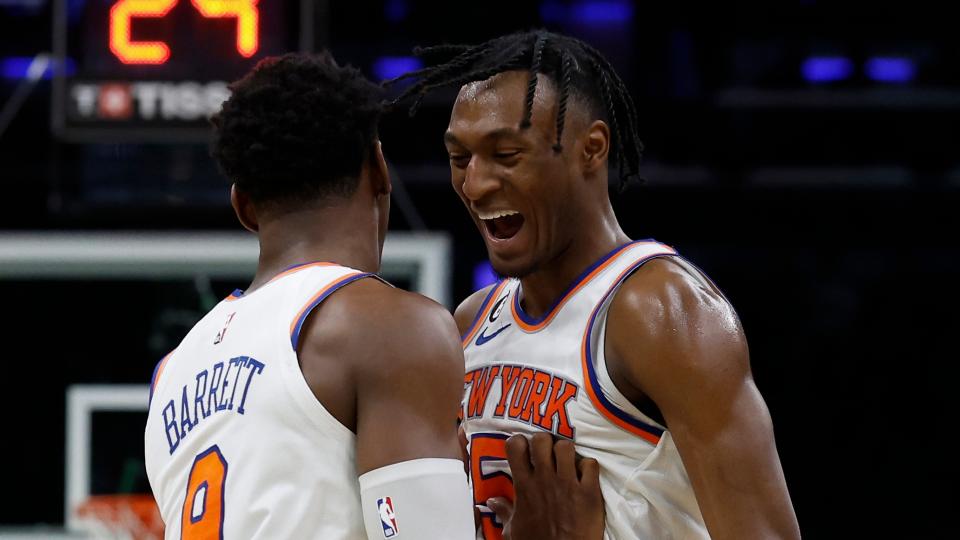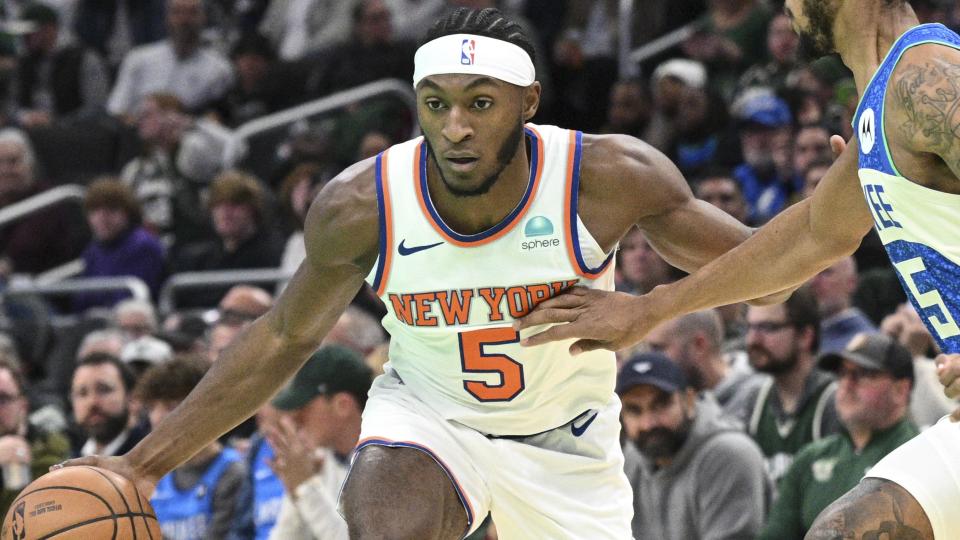Grading the Knicks' trade for OG Anunoby with the Raptors
In an era-defining Saturday transaction, the Knicks traded RJ Barrett, Immanuel Quickley and a 2024 second-round pick in exchange for OG Anunoby, Precious Achiuwa and Malachi Flynn.
This marks the departure of two of the longest-tenured Knicks - both committed, developing young talents - in a consolidation trade for one of the league’s premier 3-and-D wings.
This is undoubtedly the highest-risk play of Leon Rose’s years leading New York, with his two biggest moves to this point being hiring Tom Thibodeau and signing Jalen Brunson. Emotions are sure to be high after a franchise-altering decision of this caliber, and we won’t see the final effects of this deal for years, but for now, let’s do our best to objectively grade this trade for the Knicks.
The good
New York got the best player in this deal in Anunoby. The 26-year-old stands 6-foot-7, 232 pounds and is in the top tier of wing defenders in the league while averaging 15.1 points, 3.9 rebounds and 2.6 assists on 60.8 percent shooting from two and 37.4 percent from three this season.
The counting stats don’t capture his impact sufficiently. He was named to the All-Defensive Second Team last season, leading the NBA in steals and playing a key role in Toronto’s defense hovering between elite and above average the last five seasons.
Nobody can really stop the Jayson Tatums and Jimmy Butlers of the world, but Anunoby is about as good an option you can throw at them without employing a top-five perimeter defender in basketball (which he might be). He’s now arguably the Knicks’ second-most athletic player, and has that Thibs team grit and grind to him.
His offense has also been limited playing with two extremely similar and higher prioritized players this year. Brunson and Julius Randle offer more spacing (mostly the former) and diversity of placement for Anunoby, one of many qualities that make him a terrific fit in New York.
He’ll be a shooting boost over Barrett in the core lineups, with a 38.2 percent average from three over the last five seasons compared to RJ’s 34.2 percent career clip. He’s more efficient in transition and on cuts thanks to his athleticism and ferocious finishing, shooting 75.3 percent from the rim and putting down 103 dunks to Barrett’s 29 this year.
Anunoby is set up to be the perfect third wheel fans hoped Barrett would be. RJ’s always been more promise than practical, shoots 42 percent from the field this season and as a career average, and has too many month-long stretches of being the worst player on the court.
This isn’t to downplay Barrett’s tremendous service to the Knicks over these last few seasons, but fans will immediately feel the jump in quality from his replacement. Quickley was the real loss in terms of short and long-term winning basketball impact, but was due for departure as soon as the Knicks didn’t meet his extension price.
They’d have to pay up to $30 million this summer to retain him, and between how much the Knicks value cap flexibility and the inability to find Quickley 30 minutes in this rotation, there was no realistic route to him staying long-term. They’ll need to replace his secondary creation and energy off the bench for sure, but he’s effectively replacing the draft capital New York didn’t give up in this trade.
That’s another major win, the Knicks upgrading at the top without sacrificing any first-round picks. Their trove is still primed for the all-in trade we’ve waited for, which this deal is clearly a precursor to.
As a value proposition, the Knicks did well here. It’s hard to imagine Barrett carried much with his play, and while Quickley is a special talent, he’s only two years younger than Anunoby, and that big wing archetype probably pays off better in the championship hunt.
This trade could still be a success for the Knicks even if Barrett makes the leap and Quickley continues his growth. Anunoby’s positional flexibility and two-way talent paired with the capital to still add a superstar to the lineup could ultimately render the opportunity cost moot.
Some may point to Anunoby’s player option for next season as a risk of him bolting this summer, but given his agent’s Knicks connections and the pieces New York gave up, it would be shocking if this weren’t a long-term engagement. On top of Anunoby, the Knicks received two rotation guys they can use to fill out the remaining gaps in their roster.
Achiuwa is an immediate upgrade at the backup center slot, which isn’t the highest bar but is a nice stopgap. He’s 24 years old and has shown some interesting flashes from three and off the dribble, so could ultimately end up a real plus on the roster.
Flynn will likely compete with Miles McBride for the backup point guard slot and has a real chance to supplant him. He plays hard defensively, can shoot the three and zips into the paint better than his competitor.

The bad
In terms of 1:1 value, this trade could end up looking rough if the Knicks fail to seriously compete and their two draft picks blossom elsewhere. Anunoby may be the best individual talent today, but collectively Barrett and Quickley can bring more to teams at their peaks.
Barrett had a landmark postseason in 2023, followed by a standout FIBA World Cup and heater of a start to the 2023-24 season. He’s since flamed out drastically, but that stretch and this season can’t be written off already.
When Barrett is playing to his best ability, he and Quickley have too much talent to give up in a vacuum for Anunoby. That’s just based on what we’ve seen thus far - both their ceilings are conceivably higher than Anunoby’s.
Barrett’s shown the ability to contribute in all facets while averaging an efficient 20 points. Knicks fans waited for those flashes to translate into a whole season, but their front office couldn’t wait any longer.
Quickley may be the bigger hit. 20-4-4 guards that also guard extremely well don’t come around often, and he’s likely growing from there.
Some have compared the Quickley departure to the Thunder trading James Harden, the Clippers dealing Shai Gilgeous-Alexander, or the Kings with Tyrese Haliburton. That’s probably extreme, but the Knicks could definitely look back with some regret, especially around the original extension talks.
Anunoby is a strong player, but he’ll essentially function as a buffed RJ, not the surefire All-Star return you expect for giving up two key young pieces. Like with Barrett, Raptors fans have eagerly awaited the OG leap, and the supposed factors blocking it in Toronto are present in New York.
He has his flaws as a player too. He doesn’t get to the free-throw line nearly enough, is a good-not-great shooter, and offers less than Barrett creating on his own.

That needs to be folded into the value equation as well: the Knicks are now down their third and fourth-best individual offensive engines and replaced them with a worse one. They also gave up a non-inconsequential second-round pick, the best of their bunch of 2024 selections.
There are reasons to favor the other alternatives to this deal too. For one, they could have kept Quickley and instead dealt some picks, maintaining more roster integrity and long-term talent in exchange for ammo for “the big one.”
There’s also the other players they could have targeted with this package. Dejounte Murray and DeMar DeRozan are two more offense-centric options that are arguably better than Anunoby.
It’s usually the Knicks offense that hits a wall come the postseason, and Anunoby doesn’t materially change that dynamic at all, let alone as much as those other names. A follow-up move isn’t a luxury, but a necessity at this point, given they’re still not a contender and Quickley leaves a major hole.
The grade
A year from now, this trade will look nothing like it does today, that’s just how moves of this magnitude end up playing out. Follow up moves make the original one clearer, as guys’s careers unfold in dramatically unexpected ways.
The Knicks could also “lose” this trade while winning the greater goal, things work out that way. We won’t truly know how to grade this deal as a success or failure for years.
Still, for the sake of an initial reaction, this looks like a classic Leon Rose move, improving the team while maintaining flexibility for the grand plan. It’s his first big risky trade, but there appears to be more assured upside than potential downside when weighing the larger context.
Grade: B+

